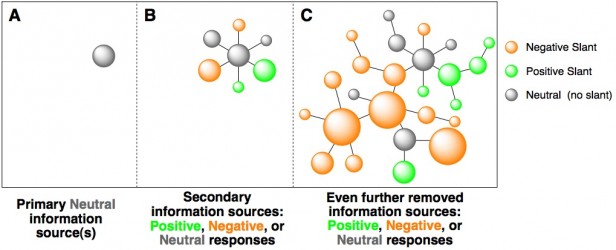This is part 3 of a 3ish part series on navigating the language of chemicals. Read an introduction, part 1, part 2, and part 2.5 if you wish.
When researching the chemicals in a product, the curious consumer will most likely encounter information presented in several different styles and with varying degrees of usefulness. The goal of this post is to look at how a reader can begin to evaluate the reliability of an information source.
Neutrality vs. Slant.
Some sources try very hard to state facts neutrally, but most have subtle or overt emotional undertones. The difference between a neutral source and a biased source is not always clear-cut, but everything falls somewhere on a spectrum:

Here are a few examples from the wealth of information available about Brazilian Blowout on the internet:
Positive Slant: The Brazilian Blowout is the most innovative and effective professional smoothing treatment in the world! (source)
Negative Slant: Brazilian Blowout contains 100 times the limit of allowable formaldehyde. WOW!!! This company is deceiving the hairdressers and putting their lives at risk. (source)
Neutral (no slant): One safety issue we’ll be evaluating is whether formaldehyde may be released into the air after the product is applied to the hair and heated. (source)
There’s a time and a place for emotions, and material written with a positive or negative slant can be informative and/or entertaining. However, when a source allegedly purposes to present scientific facts, there needs to be a hefty dose of neutrality. Science, after all, is supposed to be based on logic, not emotion.
For scientifically accurate information about product safety or benefits, look for these grammatical hallmarks of neutral writing :
• It rarely uses exclamation marks
• It rarely uses superlatives or absolutes (best, worst, most, least, always, never)
• It’s probably a bit dry to read (unfortunately)
The Game of Telephone, or “Don’t Take My Word For It”
When a bit of scientific information is discovered, it may be announced in a very neutral matter-of-fact way (A, below). However, readers/hearers can respond to these facts positively or negatively (B, below). Readers/hearers of those readers/hearers can in turn respond, and soon the majority of information available on a topic has been filtered through human emotional biases (C, below).

Therefore, it’s important for scientific information to cite sources. Reliable scientific discourse doesn’t assume that the reader will be content to just passively trust whatever he or she reads. If you, as a reader, ask “but how?” or “but why?” to any of the author’s claims, you should eventually arrive at a primary publication about scientific research (perhaps that initial grey dot in the scheme above).
(Note that such publications may not be accessible to the public without paying a fee – you may have to use a computer at a university to gain free access. Alternatively, this is when it can actually come in handy to have a neighbor who’s a chemist.)
Chemistry-Specific Conventions
When it comes to writing about chemicals, there are certain syntactical/grammatical anomalies that you can keep an eye out for, which might hint that the writer doesn’t really know as much as one might hope. These may seem like really minor things, but they are conventions that should be learned early on in a formal chemistry education.
Personally, I start to lose confidence in a source when the following chemistry blunders are made repeatedly:
• Capitalizes the names of chemicals (other than in captions/titles/lists or at the beginning of a sentence. This might be different in languages other than English (?))
• Uses absurd significant figures, or acts like it’s important to specify something to the 12th decimal place.
• Repeatedly uses a chemistry term in the exact same phrase, as if the author doesn’t know how to use the term in an original sentence, so sticks to the sentence context he/she picked up from some other source.
Being Upfront about Not Being Strictly Scientific
 In a discussion about product safety, people will sometimes take a “better safe than sorry” approach. This means that they don’t exactly have the hard science to back up a decision to treat a product as unsafe, but they also don’t feel comfortable trusting that it is safe. They deal with this gray zone by choosing to treat the product as if it’s unsafe. Guilty until proven innocent.
In a discussion about product safety, people will sometimes take a “better safe than sorry” approach. This means that they don’t exactly have the hard science to back up a decision to treat a product as unsafe, but they also don’t feel comfortable trusting that it is safe. They deal with this gray zone by choosing to treat the product as if it’s unsafe. Guilty until proven innocent.
This approach to safety is fine in my opinion, just so long as it’s clear that that’s what’s going on. You run into trouble when someone takes the better-safe-than-sorry approach but claims that they’re arriving at a decision based only on hard facts.
Summary: Respectful Writing
These (fuzzy) guidelines for evaluating the reliability of scientific information boil down to the title of this post – reliable information is written respectfully. Take a look at the information you’re reading, and decide if the writing…
(1) Respects the reader? Is it written like the author thinks they can fool you into feeling a certain way? Is the writer bluffing by making a series of “scientific” claims without offering you a trail of bread crumbs to understand where they’re coming from?
(2) Respects science and scientific reasoning? Does one claim lead logically into the next? Does the author keep emotion reasonably separated from the facts? Claims without substantiation are worthless, scientifically speaking – are you given data to back up claims?
(3) Respects language and writing conventions? If the author claims to be a scientist, he/she should make an effort to follow the conventions of that branch of science.
Conclusion. This concludes what I had planned for this little series. I shall now return to my regularly scheduled programming, whatever that is. Thanks for reading : )


Nicely done. I am certainly going to be careful next time I use Brazilian Blowout!!! If only most writing about all sciences followed these guidelines.
Whether a writer uses exclamation points or other obvious clues to slanting intentions or not, a circumspect and reasonable reader should always take what he or she reads with an appropriate amount of organic salt.